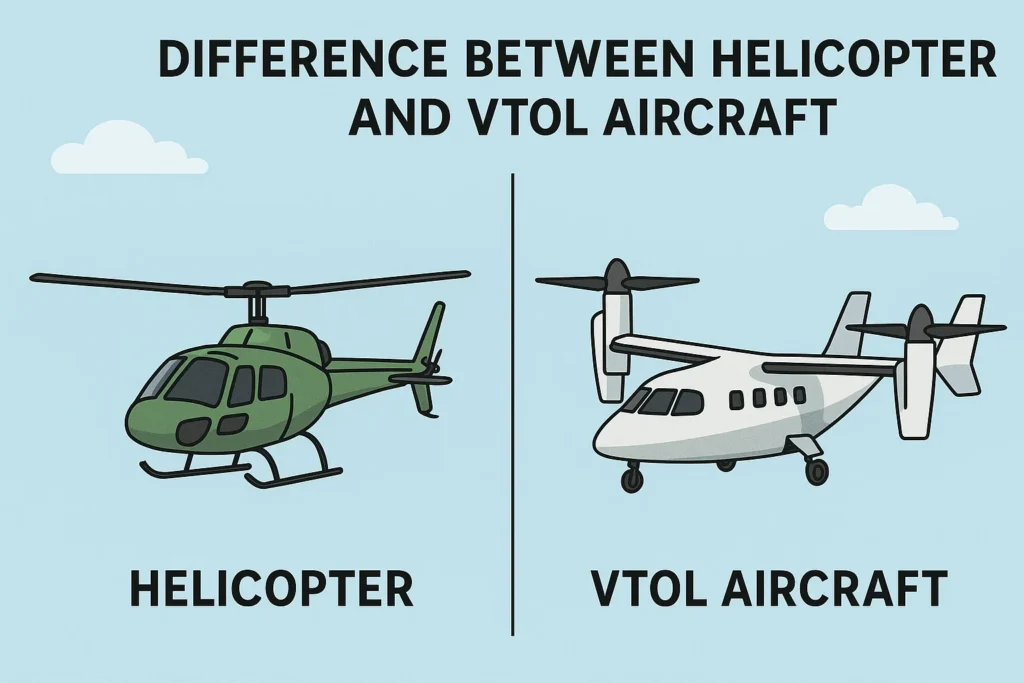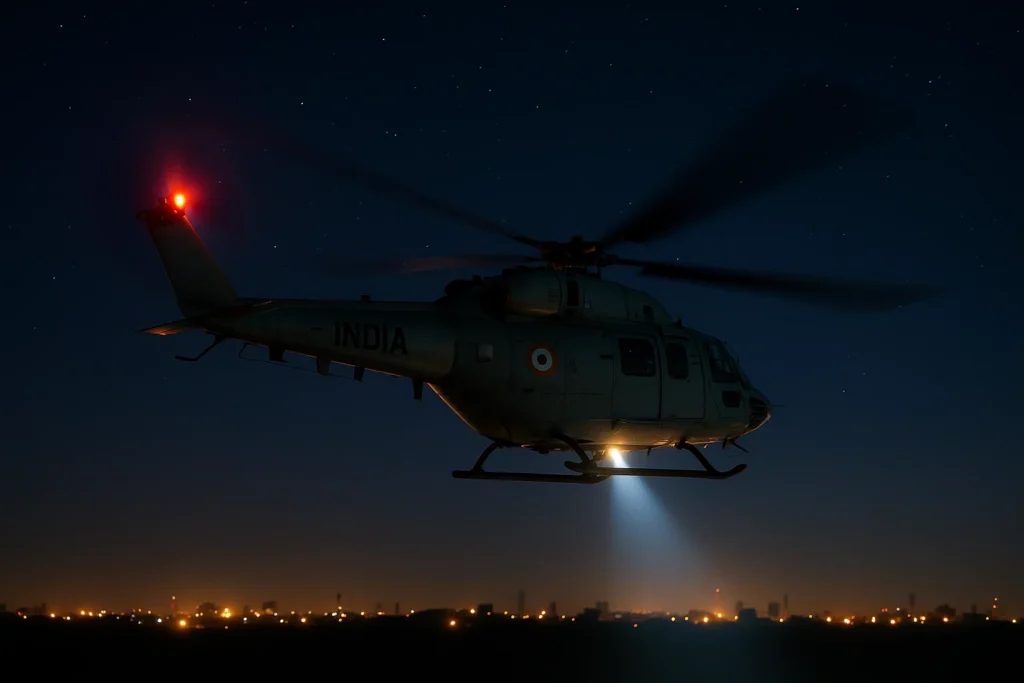✨ Introduction: Difference Between Helicopters and VTOL Aircraft
When it comes to vertical take-off and landing capabilities, helicopters and VTOL aircraft are two of the most prominent technologies in the field of aviation. Both aircraft types can take off and land vertically, making them ideal for operations in areas with limited space, such as urban environments or remote regions.
However, while they share some similarities, helicopters and VTOL (Vertical Take-Off and Landing) aircraft have distinct differences in their designs, operational capabilities, and applications.
In this blog, we’ll explore the key differences between helicopters and VTOL aircraft, and help you understand how these two types of aircraft compare in the aviation industry.
🌍 What is a Helicopter?
🚁 Design and Functionality
A helicopter is a type of rotary-wing aircraft that uses one or more horizontal rotors to generate lift and propulsion. The rotor blades spin at high speeds, creating downward thrust that lifts the helicopter into the air.
-
Rotary Wings: The primary source of lift and thrust in a helicopter comes from its main rotor and tail rotor (for stabilization).
-
Hovering Capability: Helicopters are capable of hovering in place, making them highly versatile for tasks like aerial photography, search and rescue, and VIP transport.
🚁 Operational Range
-
Flight Range: Helicopters typically have a range of 250 to 500 miles, depending on the model and fuel capacity.
-
Speed: Helicopters generally cruise at 100-150 mph, with top speeds reaching up to 180 mph in some high-performance models.
🚁 Applications
Helicopters are widely used in medical evacuations, offshore oil rig transport, search and rescue missions, and tourism. They are also used by militaries for reconnaissance, transport, and combat operations.
🌍 What is a VTOL Aircraft?
🛩️ Design and Functionality
VTOL aircraft are designed to take off, hover, and land vertically, just like helicopters, but their design allows them to transition to horizontal flight when airborne. This unique capability allows VTOL aircraft to fly faster and cover greater distances than traditional helicopters.
-
Fixed Wings: Unlike helicopters, VTOL aircraft are typically equipped with fixed wings that provide aerodynamic lift when transitioning to forward flight.
-
Vertical Thrust: VTOL aircraft achieve vertical lift through specialized systems, such as tilting engines or rotors, that can rotate or adjust to provide both vertical and horizontal thrust.
🛩️ Operational Range
-
Flight Range: VTOL aircraft have a wider flight range than helicopters, with some advanced models capable of flying over 1,000 miles or more.
-
Speed: VTOL aircraft can achieve higher speeds than helicopters, with some models reaching 350 mph or more, depending on the design.
🛩️ Applications
VTOL aircraft are emerging in both military and commercial sectors. They are being developed for uses such as urban air mobility (UAM), cargo transport, military operations, and high-speed passenger travel.
🌍 Key Differences Between Helicopters and VTOL Aircraft
🚁 1. Lift and Propulsion System
-
Helicopters: Use rotary wings (main and tail rotors) for both lift and propulsion.
-
VTOL Aircraft: Use fixed wings for lift during forward flight, with specialized systems (like tilting rotors or engines) for vertical lift and hovering.
🛩️ 2. Speed and Range
-
Helicopters: Typically have a lower top speed and limited range (about 250-500 miles).
-
VTOL Aircraft: Can achieve higher speeds and longer flight ranges due to their ability to transition to aerodynamic flight once airborne.
🚁 3. Fuel Efficiency
-
Helicopters: Generally less fuel-efficient than VTOL aircraft because they require constant power to maintain hover, especially during longer flights.
-
VTOL Aircraft: More fuel-efficient for longer distances because they use fixed wings for forward flight, reducing the amount of fuel needed for vertical flight.
🛩️ 4. Noise Levels
-
Helicopters: Tend to be noisier due to the rotary blades generating turbulence and air displacement.
-
VTOL Aircraft: While they also generate noise, many electric VTOL models (eVTOL) are being designed to be much quieter, making them ideal for urban environments.
🚁 5. Versatility
-
Helicopters: Are highly versatile for hovering, vertical takeoffs, and landings in confined spaces. They are widely used for aerial operations in areas with limited infrastructure, such as mountains, forests, or offshore platforms.
-
VTOL Aircraft: Offer greater versatility in terms of speed and range, as they can hover in place like helicopters but can also transition to faster horizontal flight like airplanes. This makes them ideal for future urban air mobility and long-distance travel.
🌍 Future of VTOL Aircraft vs Helicopters
🚁 Helicopters
-
Helicopters continue to play a critical role in search and rescue, medical evacuations, and tourism, thanks to their unique ability to hover and operate in confined spaces.
-
However, the future of aviation may involve more hybrid models and electric helicopters that offer quieter, more fuel-efficient flight options.
🛩️ VTOL Aircraft
-
VTOL technology, particularly in the form of electric VTOL (eVTOL) aircraft, is expected to revolutionize urban air mobility and commercial aviation. With advancements in battery technology, eVTOL aircraft can provide environmentally friendly, low-noise air transportation in cities, and for inter-city travel.
🌍 Conclusion: Helicopters vs VTOL Aircraft – Which Is Better?
Both helicopters and VTOL aircraft offer significant advantages in vertical flight capabilities, but they serve different purposes based on their designs and operational needs.
-
Helicopters remain indispensable for short-range missions, emergency services, and operations in confined spaces, thanks to their proven reliability and ability to hover.
-
VTOL aircraft, with their greater range, speed, and fuel efficiency, are poised to be a key player in the future of aviation, particularly in urban air mobility and longer-distance commercial travel.
At DreamSafar, we offer the best of both worlds, providing helicopter services for versatile aerial operations while keeping an eye on the future of VTOL technology to enhance our offerings.
🔗 Useful Links:
Resources:
❓ FAQ Section:
Q1: What is the main difference between helicopters and VTOL aircraft?
A1: The main difference is that helicopters use rotary wings for both lift and propulsion, while VTOL aircraft have fixed wings for horizontal flight and specialized systems for vertical takeoff and landing.
Q2: Can VTOL aircraft fly faster than helicopters?
A2: Yes, VTOL aircraft are generally faster than helicopters due to their ability to transition to horizontal flight, similar to airplanes, whereas helicopters have limited speed in hover mode.
Q3: Will VTOL aircraft replace helicopters?
A3: While VTOL aircraft offer faster, more efficient travel for longer distances, helicopters will continue to play a key role in short-range operations and specialized tasks like emergency services and tourism.


